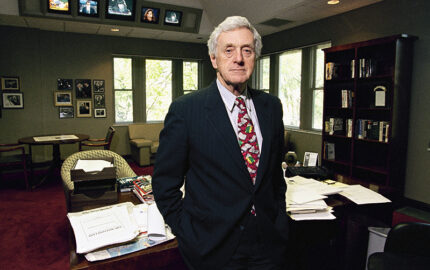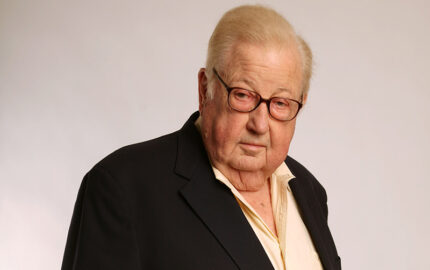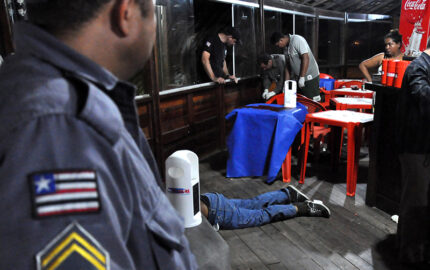 A ballpark, a boat, and a freezing, windswept ramp outside the old Boston Garden: things in threes, as the nuns used to say. I started my career as a reporter in Boston, and in the end, my holy trinity of favorite assignments involved going to Fenway to cover the first woman to cover the Boston Red Sox, joining the guests on a yacht in Boston Harbor celebrating the graduation of Edsel Ford from Babson College, and interviewing a small band of young girls who routinely skipped school in order to operate rogue fan clubs in honor of the Bruins (and the Braves). To this day, these stories play like a slide show in my mind, the images clicking past, a reminder of how little I knew and how much Boston taught me, a reminder too of something essential about the spirit of the city.
A ballpark, a boat, and a freezing, windswept ramp outside the old Boston Garden: things in threes, as the nuns used to say. I started my career as a reporter in Boston, and in the end, my holy trinity of favorite assignments involved going to Fenway to cover the first woman to cover the Boston Red Sox, joining the guests on a yacht in Boston Harbor celebrating the graduation of Edsel Ford from Babson College, and interviewing a small band of young girls who routinely skipped school in order to operate rogue fan clubs in honor of the Bruins (and the Braves). To this day, these stories play like a slide show in my mind, the images clicking past, a reminder of how little I knew and how much Boston taught me, a reminder too of something essential about the spirit of the city.The Boston I encountered in the early 1970s was scrappier than today’s version. Dublin West, people called it: “Every other face, a map of Ireland.” Boston was not exactly a toy city with toy problems (there was the Strangler, after all), but it had a pleasing human scale, especially in contrast to its rivals, New York City and Chicago. The broad strokes of the city were, and are, easy to discern: the love of learning, the mix of young and old, politics as sport, and sport as religion. Sister Corita’s art (pronounced aht) on the liquefied natural gas tanks in Dorchester, huge dripping bands of color, introduced whimsy where you least expected it. The waitresses at Durgin-Park shoved bloody slabs of rare roast beef at customers amid shouts of “More chowdah!” Their rudeness had the durability of a landmark. The Charles River, which everyone said would someday be clean enough to swim in, radiated, at best, a murky pride. On the other side of the river was Cambridge, home of MIT and Harvard, a town Bostonians sometimes dismissed as “conseeded”—practically the worst thing you can be in Boston, worse even than a Yankees fan.
In those days, half my disposable income went to Filene’s Basement, where every purchase was a word problem in math. How many days does a Priscilla of Boston wedding dress have to languish on the rack before it is marked down by one-third divided by a half minus 10 percent? Women stripped in the aisles to see if the clothing fit. Forget the Combat Zone: Filene’s Basement was known as the best peep show in town.
Boston had not only its own accent but also its own vocabulary, such as the word “pol,” short for politician. The more prominent the pol, the more likely he was to be known by his first name or nickname: Barney. Teddy. Tip. Dapper. I knew a good deal about politics in Boston before moving there. My uncle Dermot Purcell Shea worked for the state government, running the Consumers’ Council, and our house in the western part of the state was filled with talk of Volpe and Furcolo and Peabody, not to mention James Michael Curley and Honey Fitz. The mayor of my Boston: a Democrat, Kevin, youthful, promising, savvy enough to realize that the night after Martin Luther King died it would be wise not to cancel a sold-out James Brown concert at the old Garden. The governor: a Republican, Sarge, toothy, nice-looking, with a solid Yankee pedigree, savvy enough to realize that in a city filled with colleges, it was a good idea to fly the flag at half-mast after the Kent State shootings.
Boston had secret status markers: slowly but surely, like a Polaroid photo (invented by a Harvard alum), blankness yielded to smudgy impressions and then to clarity. Eventually one learned where to dine (Locke-Ober), what to order (finnan haddie), and how to describe a person who graduated from Boston College High School, Boston College, and Boston College Law School (a triple Eagle).
Back Bay and Beacon Hill overflowed with college students. Cheap digs, still possible, became even cheaper when boomers, in faded jeans and flannel shirts, piled into them and shared the rent. The less attention the tenants paid to housekeeping, the more quickly they could claim to be living in a commune. Groovy!
The South End (not the same as Southie; very confusing to an outsider) was all but abandoned, boarded up and decaying in the shadow of the new Prudential Building. Nearby, the Hancock Tower became famous because its windows keep misbehaving—kept, in fact, popping out. In Boston, the underutilized SAT word “defenestration” filtered into common conversation. As a result, everyone in Boston sounded wicked smaht.
My résumé for those days included a five-week tryout at the Record American, and then a year each at a radio outfit that harvested actualities for other media in and out of town, at the Boston bureau of Women’s Wear Daily, and at the Globe, covering the suburbs.
At the Record American, a Hearst paper, I was told to go to St. Elizabeth’s Hospital one fall morning in 1970, where a police officer, shot during a bank holdup in Brighton, lay dying. The heist was engineered by a couple of ex-cons who persuaded two college girls from Brandeis to be their accomplices, telling them that the loot would help finance the coming revolution. I was against the war in Vietnam, but I was not in favor of creating fatherless families. Several of the officer’s children (there were eight in all) had been pulled out of school, and, still in their uniforms, they gripped each other in the hospital lobby, silent, with stricken eyes, in a state of shock and grief. By all accounts their father, Walter Shroeder, was a good man from a prominent policing family who did not deserve to be caught in the crossfire. I stood to the side, immobilized. I called my editor from a pay phone and explained that I had no story. I told him I did not know how to begin to talk to these kids.
“Go up to them,” he said. “Just bullshit.”
“I can’t.”
End of tryout.
For the radio job, I lunged all over town, tape recorder in hand. My sole function was to hit the On and Off buttons, which seemed about right considering how green I was. On a June day in 1971, Daniel Ellsberg stood outside the federal courthouse in Boston, justifying his role in the release of the Pentagon Papers. He appeared intense, wiry, and confident as he challenged the clandestine acts of a government as it waged an unjust war, sacrificing boys whose fathers banished them at mealtime from the dining room table on the basis of their objectionable opinions coupled with the length of their hair.
Did I understand the momentousness of the event, the extent of the corruption Ellsberg exposed?
Not at all.
But I did get to see firsthand how history is always a player in Boston, whether you find it on the Freedom Trail or in the smell of molasses on a hot day in the North End or while observing a single individual in an act of courage.
For Women’s Wear Daily I visited Filene’s Basement as a reporter, not just a customer. I learned how 36,700 pairs of nylons were gone in three hours during World War II, and in 1955, 10,000 umbrellas (sold at $1 each) and $30,000 worth of Irish crystal both sold out in a single day. When it came time to cover high fashion in Boston, the default position was to simply interview and then reinterview the Fiandacas, father and son. Pasquale was the head tailor at the Harvard Coop, and young Alfred ruled Newbury Street. On a typical day, a customer might call Alfred Fiandaca’s salon in a panic, wanting six versions of the exact same dress in the same color for her six different homes: “I despise carrying luggage.” Alfred believed the most interesting people in the world were the very rich and the very poor. He had sympathy for his clients: “For a lot of these women, their husbands have reached a certain financial level and he’s like a bull in a field of cows. But she went to the top of the hill with him and she wants some attention.”
Of all my jobs, the best was at the Globe. The city editor, Matthew V. Storin, called to say a young reporter named George Regan was quitting as a correspondent covering night meetings in Quincy, Braintree, and Weymouth. I remember thinking, This guy is making the mistake of his life. Who cared if the job was part-time but with full-time hours and no benefits? I said yes without hesitation. The Globe was one of the most vital, raucous, crusading, and talent-heavy newspapers in America. The newsroom burst with legendary figures. Roaming the offices on Morrissey Boulevard, formal in a suit, George Frazier, the elegant elderly gossip columnist, skinny, smoking, would recall the time he interviewed some starlet or other and then he would extol duende, the Spanish concept of ineffable grace. He claimed to have a secretary who answered his correspondence with stationery that said, “From the desk of C. U. Jones.” David Nyhan covered politics. At six feet four, he was one of those strapping people amiably trailed all his life by tales of his athletic prowess: wasn’t he the guy who scored a touchdown at Harvard with a fumble recovery in the Yale end zone in 1961? Marty Nolan, in the Washington bureau, was on Nixon’s enemies list, the highest compliment you could pay a reporter at the time. Diane White and Ellen Goodman offered two bold female voices. The Spotlight Team exposed corruption. Presiding over it all was the editor in chief, Tom Winship. His spectacles and suspenders gave him the mild-mannered, distracted air of a county editor, yet he was fierce in his desire to put out a good paper, famous for his tiger notes, distributed whenever someone did a good job, notes that read simply, “Good job, tiger.”
As a suburban correspondent, I kept busy, attending night meetings and writing the occasional feature, such as a profile of Dunkin’ Donuts University, which happened to be in nearby Braintree, and an account of a local beauty contest for children: “Here she is, all 46 pounds and 43 3/4 prize-winning inches of her, Little Miss Weymouth of 1972, Laura Ann Murphy.” Still, I longed to be cut loose from the tedium and anonymity of the buttoned-down burbs—oh, to be given as assignment within city limits.
And then . . . the ballpark:
September 15, 1972. A sunlit fall day and the Sox are playing the Cleveland Indians that evening. The Globe’s crackerjack sports section, which knew everything and everybody, had received a tip: a woman from a weekly newspaper called the National Observer was threatening to sue the Sox if the team didn’t let her cover the game that night. No one was even thinking about allowing women into the locker room at that point. This was simply a matter of access to the field and the press box. Shouldn’t the Globe be sending someone as well? Did the paper want to look like a loser in these feminist sweepstakes? I had been about to go home, but changed course when I got the order to head to Fenway Park.
Before the game, the park on a perfect day looks like a dress that has yet to be worn. The clubhouse was filled with drinks on ice and featured free hot and cold running seafood. The male reporters barely gave us a glance, mouthing their cigars, tapping the ashes, hacking away on portable Olivettis, worried only that their job might be jeopardized if the extent of its cushiness ever became public.
“You girls,” said one, “are ruining our racket.”
As for the players, their indifference was democratic and universal. All they wanted, pregame, was as few distractions as possible. Some were throwing or catching a ball, some running at a slow trot, some stretching. Carl Yastrzemski acknowledged that he liked to wear the same socks on the outside if they had been worn previously in a winning game. Reggie Smith told me he didn’t like to talk to reporters in general, and it made no difference to him whether the people he didn’t like to talk to were male or female. A couple of the players smiled tolerantly, leaning on their bats, as I approached them, but they did not say anything of note. I filed a story heavy on atmosphere and short of facts, neglecting to include the final score, which, fortunately, the real baseball reporter, a guy in the sports section, did.
The boat:
It was an evening of contrasts, of black tie and sneakers along with Dramamine and moonlight.
At the age of twenty-four, Edsel Ford was the first male in the Ford Motor Company dynasty to graduate from college. Invitations were sent to Princess Grace of Monaco, Ari and Jackie Onassis, and Lady Bird Johnson, as well as two hundred Babson College classmates, on copies of the “Late Party Edition” of the Invite Tribune, which bore the motto “All the fun that’s fit to be had.” It was the classmates who showed up at Rowe’s Wharf—a half hour early, as instructed, to be checked in by security. Henry Ford, Edsel’s father, refused to say what his graduation gift had been: “Say I gave him a VW. Say whatever you like. This is a social occasion and I’m just another invited guest.”
What he had provided was “name entertainment,” as his son Edsel called it, apparently not intending the pun, referring instead to the musical services of singer-songwriter Jim Croce, belting out “Workin’ at the Car Wash Blues” and “Bad, Bad Leroy Brown,” the number one hit on the charts in the weeks before the party. Croce was Bruce before there was a Bruce.
I felt pretty marginal at the gathering—for good reason. I was marginal. With my notebook instead of a mop, I was a kind of scullery maid, necessary to some element of the enterprise—in this case, feeding vanity rather than scrubbing floors—but not worthy of notice. I remember one guest—perhaps all of twenty-two or so—exclaiming to another, “I have never been so excited about a piece of real estate in my life.” During one of the band’s breaks, I stood by a railing, staring out to sea, trying to be as invisible as I felt. A couple of the band members joined me, including Croce. He and I spoke briefly, sharing one of those stoned observations that people back then made even if they weren’t stoned, about how the words of the songs he had just sung were now out there in the night sky, probably hobnobbing with the Gettysburg Address.
The ramp:
The old Boston Garden was considered obsolete almost from the day it opened in 1928. It never had air conditioning, it was often oversubscribed, and the pillars that held it up guaranteed obstructed viewing for a fair number of fans. The back entrance, as I remember it, was a wind tunnel filled with scurrying sounds, the source of which I preferred not to contemplate. It would never be the kind of place you would want your daughter to hang out unsupervised, but a band of young girls did, a half dozen or so at a time, their candy-ravaged teeth chattering in the cold, as they elbowed each other to gain a glimpse of their favorite players, whose schedules, for both practices and game days, they had memorized. Bobby Orr comes in three hours before a game, John McKenzie is two and a half hours early, they whispered among themselves. As the self-appointed heads of fan clubs for the players, all they wanted was a smile, a wave, an autograph, any gesture whatsoever that confirmed, at least in their minds, an ongoing relationship. The turf wars over who got to be the president of which player’s fan club were largely of their own making and largely in their imaginations, but anyone who tried to head more than one of these mythical fan clubs was definitely conseeded.
The girls rarely attended the games and spent the hours they waited for a game to be over outdoors, discussing the previous game and guessing who would score in the current one. While the athletes loaded up on calories before a contest, the girls found they were too upset to eat, preparing for the moment when the players exited the building, hoping to run to the players’ cars beforehand to write congratulations on the dirty windows or to clear snow off the windshields.
One fan had a Bobby Orr jigsaw puzzle shellacked permanently in place; when she ran out of wall space, she put posters on the ceiling. Another treasured a scar on her forehead that resembled a backward number 7; in the mirror, with the left-to-right distortion, it called to mind Phil Esposito, her favorite player, the real number 7. Sometimes they would thrust gifts of stuffed animals at the athletes, asking them to put them on their beds. One girl dreamt of being run over by Derek Sanderson, because then he would be obligated to visit her in the hospital and to bring her flowers. I asked a different girl if her obsession had ever helped her with her schoolwork, and she said yes, that when she had to write a composition about “What I Would Most Like to Be,” she responded, “Hockey ice, because then the players would need me and they would think about me even when they weren’t at the rink.”
I loved her answer. I wanted to say: Keep talking, kid, you are a five-dollar raise.
A few days after my story appeared, the girls at the Garden were rousted by truant officers and forced back into the classroom. The power of the press.
I have not lived in Boston for many years now. The old Record American, combining forces with the old Herald Traveler, is long gone. The Boston bureau of Women’s Wear Daily closed many years ago as well, due to a perceived lack of glamour in a city where the dowagers don’t buy ball gowns. They inherit them. The kid who I thought was making the biggest mistake of his life by leaving the Globe, George Regan, went on to run the Regan Communications Group, which counts the Boston Celtics, Legal Sea Foods, and Suffolk University among its clients. It is the largest privately held public relations firm in New England, the ninth largest in the nation. Jim Croce died with the rest of his band in a plane crash about three weeks after singing for Edsel. Alfred Fiandaca died a few months before the marathon bombings, but not before he finished putting the finishing touches on a museum-worthy dress of dupioni silk for the daughter of his first cousin, who wore it with pride on her wedding day.
Yet the city beats on, and every time I visit, I marvel at its present incarnation, at its prosperity and its life. At the same time, I am borne back ceaselessly to the past, to a ballpark, a boat, and a ramp. All my life I have carried my memories of those places close to me, like charms, like lucky socks.
Each proved indelible for a different reason.
Covering the Sox that one time, even as a stunt, ushered me into their history. I am at best a footnote to a footnote, but I can feel forever that I have been folded into a story larger than my own.
History really is always a player in Boston, even on Yawkey Way. Especially on Yawkey Way.
Edsel Ford’s party may have been more ostentatious than most, and his dad may have been more snappish than a lot of dads when he said, “Say I gave him a VW. Say whatever you like. This is a social occasion and I’m just another invited guest.” And it may have taken Edsel five years to get through school (blame it on mono), and his dad may have donated money to the college’s building fund (supposedly three quarters of a million dollars). But it was still a night to remember, gilded, Gatsby-like.
The essence of the scene—the proud family moment when a young person is celebrating his or her graduation—is repeated all the time in Boston, with its own variations on a theme. Boston reveres the past, but it is in love with the future.
Boston is a launch pad—for humans.
And when I think of the young girls at the Garden, I think they could comfortably exist in the pages of two great Boston writers, Dennis Lehane and George V. Higgins, who once said: “Dialogue is character, and character is action.” Which surely applies to someone who wants to be “hockey ice, because then the players would need me and they would think about me even when they weren’t at the rink.”
These kids were original.
They could not have been more individualistic or more feisty.
They had mastered that incredible trait everyone associates with Boston, that don’t-tread-on-me defiance.
They were survivors.
Just like their city.
Essay adapted from "Our Boston: Writers Celebrate the City They Love," edited by Andrew Blauner. Copyright © 2013. Reprinted by permission of Houghton Mifflin Harcourt Publishing Co. All rights reserved. For every copy sold, Houghton Mifflin Harcourt will donate $5 to the One Fund.


